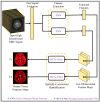Emerging Trends in Fast MRI Using Deep-Learning Reconstruction on Undersampled k-Space Data: A Systematic Review
- PMID: 37760114
- PMCID: PMC10525988
- DOI: 10.3390/bioengineering10091012
Emerging Trends in Fast MRI Using Deep-Learning Reconstruction on Undersampled k-Space Data: A Systematic Review
Abstract
Magnetic Resonance Imaging (MRI) is an essential medical imaging modality that provides excellent soft-tissue contrast and high-resolution images of the human body, allowing us to understand detailed information on morphology, structural integrity, and physiologic processes. However, MRI exams usually require lengthy acquisition times. Methods such as parallel MRI and Compressive Sensing (CS) have significantly reduced the MRI acquisition time by acquiring less data through undersampling k-space. The state-of-the-art of fast MRI has recently been redefined by integrating Deep Learning (DL) models with these undersampled approaches. This Systematic Literature Review (SLR) comprehensively analyzes deep MRI reconstruction models, emphasizing the key elements of recently proposed methods and highlighting their strengths and weaknesses. This SLR involves searching and selecting relevant studies from various databases, including Web of Science and Scopus, followed by a rigorous screening and data extraction process using the Preferred Reporting Items for Systematic Reviews and Meta-Analyses (PRISMA) guidelines. It focuses on various techniques, such as residual learning, image representation using encoders and decoders, data-consistency layers, unrolled networks, learned activations, attention modules, plug-and-play priors, diffusion models, and Bayesian methods. This SLR also discusses the use of loss functions and training with adversarial networks to enhance deep MRI reconstruction methods. Moreover, we explore various MRI reconstruction applications, including non-Cartesian reconstruction, super-resolution, dynamic MRI, joint learning of reconstruction with coil sensitivity and sampling, quantitative mapping, and MR fingerprinting. This paper also addresses research questions, provides insights for future directions, and emphasizes robust generalization and artifact handling. Therefore, this SLR serves as a valuable resource for advancing fast MRI, guiding research and development efforts of MRI reconstruction for better image quality and faster data acquisition.
Keywords: Deep Bayesian Learning; Magnetic Resonance Imaging; acquisition time reduction; compressive sensing; deep MRI reconstruction; deep dictionary learning; deep learning; fast MRI; k-space; parallel MRI.
Conflict of interest statement
The authors declare no conflict of interest.
Figures












Similar articles
-
Emerging Trends in Magnetic Resonance Fingerprinting for Quantitative Biomedical Imaging Applications: A Review.Bioengineering (Basel). 2024 Feb 28;11(3):236. doi: 10.3390/bioengineering11030236. Bioengineering (Basel). 2024. PMID: 38534511 Free PMC article. Review.
-
ReconResNet: Regularised residual learning for MR image reconstruction of Undersampled Cartesian and Radial data.Comput Biol Med. 2022 Apr;143:105321. doi: 10.1016/j.compbiomed.2022.105321. Epub 2022 Feb 19. Comput Biol Med. 2022. PMID: 35219188
-
Advancing MRI Reconstruction: A Systematic Review of Deep Learning and Compressed Sensing Integration.ArXiv [Preprint]. 2025 Feb 1:arXiv:2501.14158v2. ArXiv. 2025. PMID: 39975448 Free PMC article. Preprint.
-
Greybox: A hybrid algorithm for direct estimation of tracer kinetic parameters from undersampled DCE-MRI data.Med Phys. 2024 Jul;51(7):4838-4858. doi: 10.1002/mp.16935. Epub 2024 Jan 12. Med Phys. 2024. PMID: 38214325
-
From Compressed-Sensing to Artificial Intelligence-Based Cardiac MRI Reconstruction.Front Cardiovasc Med. 2020 Feb 25;7:17. doi: 10.3389/fcvm.2020.00017. eCollection 2020. Front Cardiovasc Med. 2020. PMID: 32158767 Free PMC article. Review.
Cited by
-
Unlocking Deeper Insights into Medical Images with Machine Learning.Bioengineering (Basel). 2025 Apr 25;12(5):451. doi: 10.3390/bioengineering12050451. Bioengineering (Basel). 2025. PMID: 40428070 Free PMC article.
-
A dynamic reconstruction and motion estimation framework for cardiorespiratory motion-resolved real-time volumetric MR imaging (DREME-MR).ArXiv [Preprint]. 2025 Jul 2:arXiv:2503.21014v2. ArXiv. 2025. Update in: Phys Med Biol. 2025 Aug 08. doi: 10.1088/1361-6560/adf9b9. PMID: 40196152 Free PMC article. Updated. Preprint.
-
Optimized MR pulse sequence for high-resolution brain 3D-T1ρ mapping with weighted spin-lock acquisitions.Magn Reson Med. 2025 Apr;93(4):1458-1470. doi: 10.1002/mrm.30412. Epub 2024 Dec 22. Magn Reson Med. 2025. PMID: 39710884
-
Evaluation of Image Quality and Scan Time Efficiency in Accelerated 3D T1-Weighted Pediatric Brain MRI Using Deep Learning-Based Reconstruction.Korean J Radiol. 2025 Feb;26(2):180-192. doi: 10.3348/kjr.2024.0701. Korean J Radiol. 2025. PMID: 39898398 Free PMC article.
-
Feasibility of magnetization-transfer-contrast relaxation-enhanced angiography without contrast and triggering (REACT) imaging at 1.5 T combined with deep learning-based reconstruction for cardiovascular visualization.Quant Imaging Med Surg. 2025 Apr 1;15(4):3222-3236. doi: 10.21037/qims-24-2199. Epub 2025 Mar 28. Quant Imaging Med Surg. 2025. PMID: 40235803 Free PMC article.
References
-
- Chen Y., Schönlieb C.B., Lio P., Leiner T., Dragotti P.L., Wang G., Rueckert D., Firmin D., Yang G. AI-based reconstruction for fast MRI—A systematic review and meta-analysis. Proc. IEEE. 2022;110:224–245. doi: 10.1109/JPROC.2022.3141367. - DOI
-
- Zhou B., Zhou S.K. DuDoRNet: Learning a dual-domain recurrent network for fast MRI reconstruction with deep T1 prior; Proceedings of the IEEE/CVF Conference on Computer Vision and Pattern Recognition; Seattle, WA, USA. 13–19 June 2020; pp. 4273–4282.
Publication types
Grants and funding
LinkOut - more resources
Full Text Sources

